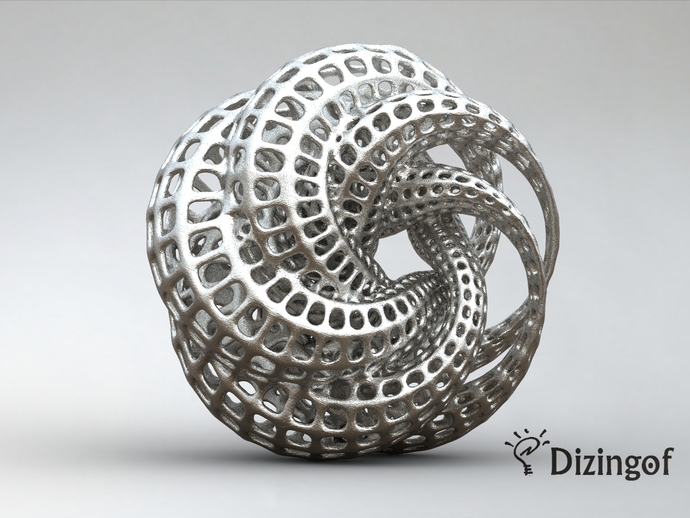A Creative Commons license on a 3D printed sculpture does not mean that you can print it however you want.
 The past few days have seen an increase incomplaints by 3D printing designers about how companies that manufacture 3D printers use their designs. It raises questions about how copyright works in the world of 3D printing, and what it means to release designs under a Creative Commons license.
The past few days have seen an increase incomplaints by 3D printing designers about how companies that manufacture 3D printers use their designs. It raises questions about how copyright works in the world of 3D printing, and what it means to release designs under a Creative Commons license.
Copyright Still Exists in 3D Printing
One of the things that makes 3D printing so interesting is that, especially when compared to the world of music and movies, lots of 3D printed objects are not protected by copyright (or any type of intellectual property right) at all. However, the fact that many 3D printed things are not protected by copyright does not mean that all 3D printed things are not protected by copyright.
While the line between what is protected and what is not can be a bit complicated sometimes (here is a whitepaper to help you with the details), there is a fairly straightforward rule of thumb: purely artistic things are probably going to be protected by copyright, while purely functional things are probably not going to be protected by copyright.
Sculptures are Artistic
Obvious members of that “purely artistic” category are abstract sculptures. Just because they are created in a virtual CAD environment or were designed with 3D printing in mind does not prevent them from being protected by copyright. And that copyright comes with certain protections and rights.
The most obvious of those rights is the right to decide who gets to copy or reproduce the sculpture. If you want to copy a sculpture that is protected by copyright, you either need permission from the person who owns the copyright or a reason not to need permission like fair use.
Copying that sculpture without permission can get expensive. Copyright law lets a courtassume damages up to $150,000 per work if the infringement is willful. The person who owns the copyright does not even have to prove damages – she can just point to the number in the law and demand that much.
Creative Commons is Permission, but not Permission to Do Whatever You Want
If you own a copyright, you can condition your permission (your “license”) on pretty much whatever you want. Creative Commons has created a collection of licenses that lets people condition permission to copy on a handful of easy-to-understand factors. Copy all you want, but give me attribution. Copy all you want, but give me attricution and make your copies available in the same way to everyone. Copy all you want, as long as you give me credit and it is not for a commercial purpose.
As long as you comply with the license, you are copying with permission and not infringing on copyright. But if you copy without complying with the license you are infringing on copyright. That is just as true for things with Creative Commons licenses as it is with any other thing protected by copyright. And remember, copyright infringement can get expensive.
Which Brings us to Trade Shows and 3D Printing Companies
One of the most impressive things to watch is a 3D printer print a really cool abstract sculpture. Besides being an interesting process, some abstract sculptures – especially ones that contain shapes you have not seen before or that are hard to make with traditional manufacturing techniques – help people understand the potential of 3D printing. Because of that, it is not a surprise that 3D printer manufactures often use abstract sculptures to show off their machines at trade shows and other promotional events.
But remember, printing an abstract sculpture is creating a copy. If that sculpture is protected by copyright, in order to create a copy those companies need a license. For example, if the license is a Creative Commons attribution license, they need to give the designer credit (here’s an easy way to do that). Without credit, those copies infringe on the designer’s copyright.
And if the license is a Creative Commons non-commercial license, it is a bad idea for these companies to exclusively rely on that license for permission to print it at a trade show or in advertising. While what constitutes commercial and non-commercial use can sometimes get tricky in the context of Creative Commons, a trade show or an ad for a commercial product is a pretty straightforward commercial use.
None of this means that it is impossible for 3D printing companies to feature Creative Commons non-commercial-licensed designs at trade shows or in commercials. It just means that those companies cannot solely rely on the offered Creative Commons licenses to do so. Instead, they need to reach out to designers and negotiate a new license that allows them to use the designs commercially.
What Happens if Copying Continues?
What can a designer do if they see a design being used in a way that does not comply with the generally available license? Ultimately that is up to them. The best thing to do is probably to reach out to the company and try and negotiate a license. But if that fails, there is always a copyright lawsuit. $150,000 worth of damages (per work) tends to get the attention of even the biggest 3D printer manufacturer.
Image by Thingiverse user Dizingof.